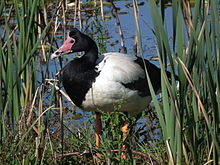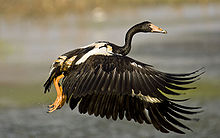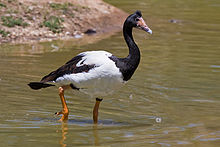- Magpie Goose
-
Magpie Geese 
At Edithvale Wetland, Melbourne, Australia Conservation status Scientific classification 
Kingdom: Animalia Phylum: Chordata Class: Aves Order: Anseriformes Family: Anseranatidae Subfamily: Anseranatinae
Sclater, 1880Genus: Anseranas
Lesson, 1828Species: A. semipalmata Binomial name Anseranas semipalmata
(Latham, 1798)Synonyms Anas semipalmata Latham, 1798
The Magpie Goose (Anseranas semipalmata) is a waterbird species found in coastal northern Australia and savannah in southern New Guinea. It is a unique member of the order Anseriformes, and arranged in a family and genus distinct from all other living waterfowl. The Magpie Goose is a resident breeder in northern Australia and in southern New Guinea.
Contents
Description
Magpie geese are unmistakable birds with their black and white plumage and yellowish legs. The feet are only partially webbed, although the Magpie Goose will feed on vegetable matter in the water as well as on land. Males are larger than females. Unlike true geese, the moult is gradual, and there is no flightless period. The voice is a loud honking.
Systematics and evolution
This species is placed in the order Anseriformes, having the characteristic bill structure, but is considered to be distinct from the other species in this taxon. The related and extant families, Anhimidae (screamers) and Anatidae (ducks, geese and swans), contain all the other taxa. The Magpie Goose is contained in the genus Anseranas and family Anseranatidae, which are monotypic in our age.[2]
A cladistic study of the morphology of waterfowl found that the Magpie Goose was an early and distinctive offshoot, diverging after screamers and before all other ducks, geese and swans.[3]
This family is quite old, a living fossil, having apparently diverged before the Cretaceous–Paleogene mass extinction — the relative Vegavis iaai lived some 68-67 million years ago. The fossil record is limited, nonetheless. The enigmatic genus Anatalavis (Hornerstown Late Cretaceous or Early Paleocene of New Jersey, USA - London Clay Early Eocene of Walton-on-the-Naze, England) is sometimes considered to be the earliest known anseranatid. Other Paleogene birds sometimes considered magpie-geese are the genera Geranopsis from the Hordwell Formation Late Eocene to the Early Oligocene of England and Anserpica from the Late Oligocene of Billy-Créchy (France).[4] The Australian distribution of the living species ties in well with the presumed Gondwanan origin of Anseriformes, but Northern Hemisphere fossils are puzzling. Perhaps the magpie-geese were one of the dominant groups of Paleogene waterfowl, only to become largely extinct later.
Ecology and status
The Magpie Goose is found in a variety of open wetland areas such as floodplains and swamps. It is fairly sedentary apart from some movement during the dry season. They are colonial breeders and are gregarious outside of the breeding season when they can form large and noisy flocks of up to a few thousand individuals. Its nest is on the ground, and a typical clutch is 5-14 eggs. Some males mate with two females, all of which raise the young, unlike some other polygamous birds. This may be beneficial when predation of young is high as chicks raised by trios are more likely to survive.
This species is plentiful across its range, although this is significantly reduced in comparison to the range at time of European settlement. The range once extended as far south as the Coorong and the wetlands of the South-east of South Australia and Western Victoria. For Australia as a whole, it is not threatened and has a controlled hunting season when numbers are large. However, most of the southern populations were extirpated in the mid-20th century by overhunting and habitat destruction. The species has been subject to reintroduction projects such as Bool Lagoon between Penola and Naracoorte. Populations in more northern areas have again reached a level where it can be regularly utilized by hunters, although not in the example provided. In Victoria, the Magpie Goose was listed as near threatened on the 2007 advisory list of threatened vertebrate fauna in Victoria.[5] In the December 2007 Flora and Fauna Guarantee Act list of threatened fauna, it is also listed.[6][7] As of early 2008, an Action Statement for the recovery and future management of this species had not been prepared.[8]
Footnotes
- ^ BirdLife International (2009)
- ^ Myers, P. et al. (2008)
- ^ Livezey, Bradley C. (1986). "A phylogenetic analysis of recent anseriform genera using morphological characters." (Full text). Auk 103 (4): 737–754. http://elibrary.unm.edu/sora/Auk/v103n04/p0737-p0754.pdf.
- ^ Hugueney, M. et al. (2003)
- ^ VDSE (2007a)
- ^ The FFGA list does not distinguish different threat categories.
- ^ VDSE (2007c)
- ^ VDSE (2007b)
References
- BirdLife International (2004). Anseranas semipalmata. 2006. IUCN Red List of Threatened Species. IUCN 2006. www.iucnredlist.org. Retrieved on 11 May 2006.
- Carboneras, C. (1992) Family Anatidae (Ducks, Geese and Swans), Pp. 536–630 in; del Hoyo, J., Elliott, A. & Sargatal, J. eds. Handbook of the Birds of the World, Vol 1, Ostrich to Ducks Lynx Edicions, Barcelona. ISBN 84-87334-09-1
- Clements, James, (2007) The Clements Checklist of the Birds of the World, Cornell University Press, Ithaca
- Hugueney, Marguerite; Berthet, Didier; Bodergat, Anne-Marie; Escuillié, François; Mourer-Chauviré, Cécile & Wattinne, Aurélia (2003): La limite Oligocène-Miocène en Limagne: changements fauniques chez les mammifères, oiseaux et ostracodes des différents niveaux de Billy-Créchy (Allier, France) [The Oligocene-Miocene boundary in Limagne: faunal changes in the mammals, birds and ostracods from the different levels of Billy-Créchy (Allier, France)] [French with English abstract]. Geobios 36(6): 719–731. doi:10.1016/j.geobios.2003.01.002 (HTML abstract)
- IUCN (2009) BirdLife International Nothocercus bonapartei Downloaded on 8 January 2009
- Madge, Steve & Burn, Hilary (1987): Wildfowl : an identification guide to the ducks, geese and swans of the world. Christopher Helm, London. ISBN 0-7470-2201-1
- Myers, P.; Espinosa, R.; Parr, C.S.; Jones, T.; Hammond, G.S. & Dewey, T.A. (2008): Animal Diversity Web - Family Anseranatidae. Retrieved 2008-JUN-16.
- Pringle, J.D. (1985): The Waterbirds of Australia. National Photographic Index of Australian Wildlife, Australian Museum/Angus and Robertson, Sydney.
- Victoria Department of Sustainability and Environment (VDSE) (2007a): Advisory List of Threatened Vertebrate Fauna in Victoria - 2007. Department of Sustainability and Environment, East Melbourne, Victoria ISBN 978-1-74208-039-0 PDF fulltext
- Victoria Department of Sustainability and Environment (VDSE) (2007b): Flora and Fauna Guarantee Act of 1988: Index of Approved Action Statements. Version of 2007-OCT-29. Retrieved 2008-JUN-16.
- Victoria Department of Sustainability and Environment (VDSE) (2007c): Flora and Fauna Guarantee Act of 1988 - Threatened List December 2007. PDF fulltext
External links
Categories:- IUCN Red List least concern species
- Anseranatidae
- Geese
- Birds of South Australia
- Birds of Western Australia
- Birds of New Guinea
- Birds of Indonesia
- Living fossils
- Monotypic bird families
Wikimedia Foundation. 2010.



